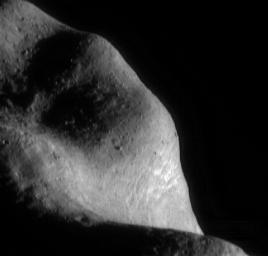
|
Boulders, Boulders, Boulders
- Click the image above for a larger view
- Full-Res JPEG (423 x 405) (14.2 kB)
- Full-Res TIFF (423 x 405) (119.7 kB)
Caption:
One of the most striking features in NEAR Shoemaker images of Eros' surface is the abundance of very large boulders. This image of the southwestern part of the saddle region, taken March 6, 2000, from a range of 201 kilometers (125 miles), shows a particularly boulder-rich part of the surface. Many of the huge rocks are 50 meters (164 feet) or more in diameter. They are believed to be fragments of Eros' native rock, shattered over the eons by formation of impact craters. The impacting projectiles themselves were pulverized by the impact process and survive only as fine debris mixed into the regolith.
Background Info:
Built and managed by The Johns Hopkins University Applied Physics Laboratory, Laurel, Maryland, NEAR was the first spacecraft launched in NASA's Discovery Program of low-cost, small-scale planetary missions. See the NEAR web page at http://near.jhuapl.edu/ for more details.
Cataloging Keywords:
| Name | Value | Additional Values |
|---|---|---|
| Target | 433 Eros | |
| System | Near Earth Objects | |
| Target Type | Asteroid | |
| Mission | NEAR Shoemaker | |
| Instrument Host | NEAR Shoemaker | |
| Host Type | Orbiter | |
| Instrument | Multi-Spectral Imager (MSI) | |
| Detector | ||
| Extra Keywords | Crater, Grayscale, Impact | |
| Acquisition Date | ||
| Release Date | 2000-06-10 | |
| Date in Caption | 2000-03-06 | |
| Image Credit | NASA/JPL/JHUAPL | |
| Source | photojournal.jpl.nasa.gov/catalog/PIA02496 | |
| Identifier | PIA02496 | |
